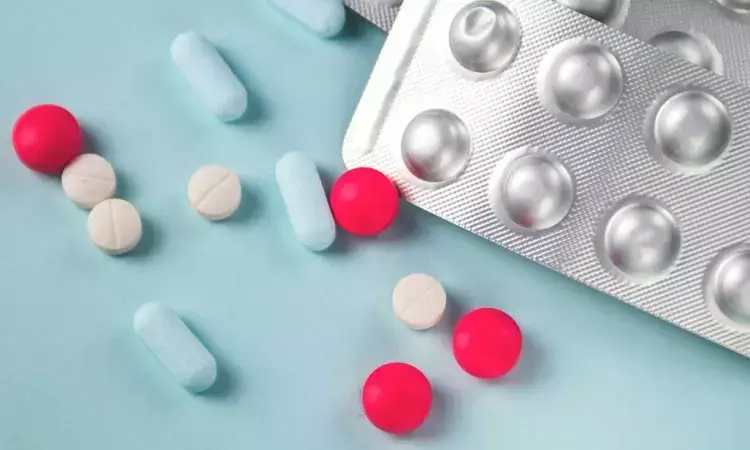- Home
- Medical news & Guidelines
- Anesthesiology
- Cardiology and CTVS
- Critical Care
- Dentistry
- Dermatology
- Diabetes and Endocrinology
- ENT
- Gastroenterology
- Medicine
- Nephrology
- Neurology
- Obstretics-Gynaecology
- Oncology
- Ophthalmology
- Orthopaedics
- Pediatrics-Neonatology
- Psychiatry
- Pulmonology
- Radiology
- Surgery
- Urology
- Laboratory Medicine
- Diet
- Nursing
- Paramedical
- Physiotherapy
- Health news
- Fact Check
- Bone Health Fact Check
- Brain Health Fact Check
- Cancer Related Fact Check
- Child Care Fact Check
- Dental and oral health fact check
- Diabetes and metabolic health fact check
- Diet and Nutrition Fact Check
- Eye and ENT Care Fact Check
- Fitness fact check
- Gut health fact check
- Heart health fact check
- Kidney health fact check
- Medical education fact check
- Men's health fact check
- Respiratory fact check
- Skin and hair care fact check
- Vaccine and Immunization fact check
- Women's health fact check
- AYUSH
- State News
- Andaman and Nicobar Islands
- Andhra Pradesh
- Arunachal Pradesh
- Assam
- Bihar
- Chandigarh
- Chattisgarh
- Dadra and Nagar Haveli
- Daman and Diu
- Delhi
- Goa
- Gujarat
- Haryana
- Himachal Pradesh
- Jammu & Kashmir
- Jharkhand
- Karnataka
- Kerala
- Ladakh
- Lakshadweep
- Madhya Pradesh
- Maharashtra
- Manipur
- Meghalaya
- Mizoram
- Nagaland
- Odisha
- Puducherry
- Punjab
- Rajasthan
- Sikkim
- Tamil Nadu
- Telangana
- Tripura
- Uttar Pradesh
- Uttrakhand
- West Bengal
- Medical Education
- Industry
Triple Drug Therapy improves Hepatic Outcomes and Insulin sensitivity in diabetics

Hepatic steatosis is common among patients with type 2 diabetes (T2D). Approximately 70% of patients who are obese or who have type 2 diabetes develop the non‐alcoholic fatty liver disease (NAFLD), and 20% of these patients show progression to non‐alcoholic High-Grade PVC.
In a recent study, researchers have found that treating T2D patients with triple therapy (metformin/exenatide/pioglitazone) had less hepatic steatosis and fibrosis and significantly improved insulin sensitivity when compared with conventional therapy, after 6 years.
The study findings were presented at the 19th Annual World Congress Insulin Resistance Diabetes & Cardiovascular Disease (WCIRDC) meeting.
The EDICT study is an ongoing single-centre (Texas Diabetes Institute) randomized controlled trial designed to compare two therapeutic approaches for the management of patients with new-onset T2DM. Dr Olga Lavrynenko and her team conducted a study to compare the efficacy of Triple Therapy (metformin/exenatide/pioglitazone) versus Conventional Therapy (metformin→glipizide→glargine insulin) on liver fat, hepatic fibrosis, and insulin resistance in newly diagnosed T2DM patients in EDICT.
The researchers included a total of 39 patients who completed the 3-year follow-up, entered the 3-year extension phase and had the measurements of hepatic fat content and liver fibrosis done at the end of the study. They assessed the measurements of FPG, FPI, HbA1c, OGTT, and body fat at baseline and study end. They also evaluated the liver function tests, AST, ALT, platelets, albumin at baseline and annually for 6 years. They determined HbA1c was >6.5% as treatment failure.
Patients received vibration-controlled transient elastography (VCTE) (FibroScan) measurement at the end of the study to provide a measure of liver fibrosis (LSM) and hepatic steatosis (CAP). From the LSM value, the severity of fibrosis was graded as <6 (F0, normal), 6 - 8 (F1/2), 8 - 12 (F3), and 12+ (F4, cirrhosis). Based on the CAP value (dB/m), the severity of hepatic steatosis was graded as either 100 - 233 (S0), 234 - 268 (S1), 269 - 300 (S2), and 300 + (S3). The researchers assessed the hepatic fat using MR spectroscopy (MRS) and performed quantitation of hepatic fat content (MRS-PDFF) using a 3- Tesla MRI Scanner.
Key findings of the study:
- Upon analysis, the researchers found that 27 of 39 (69%) patients receiving Conventional Therapy had grade 2/3 steatosis compared to 9 of 29 (31%) in triple therapy.
- They also found that 10 of 39 (26%) receiving Conventional Therapy had grade 3/4 fibrosis versus 2 of 29 (7%) in Triple Therapy.
- They noted that the Triple Therapy increased Matsuda Index of insulin sensitivity 3-fold, whereas Conventional Therapy had no effect on insulin sensitivity.
- They further noted that the severity of steatosis, measured by CAP (r = 0.42) and severity of fibrosis measured by LSM (r = -0.48) correlated inversely with the Matsuda index of insulin sensitivity.
- They observed that the severity of steatosis by MRI-PDFF also correlated with insulin resistance (HOMA-IR and Matsuda Index) (r=0.42).
The authors concluded,
- "T2DM subjects treated with Triple Therapy had less hepatic steatosis and fibrosis and markedly improved insulin sensitivity versus Conventional Therapy after 6 years.
- Hepatic steatosis and fibrosis were strongly and inversely correlated with insulin resistance.
- Antidiabetic agents that ameliorate insulin resistance reduce hepatic fat and prevent fibrosis."
For further information:
Olga Lavrynenko, MD, PhD et al., "Hepatic Steatosis, Fibrosis, and Insulin Resistance: Implications for Therapy", Abstract #0059.
Medical Dialogues Bureau consists of a team of passionate medical/scientific writers, led by doctors and healthcare researchers. Our team efforts to bring you updated and timely news about the important happenings of the medical and healthcare sector. Our editorial team can be reached at editorial@medicaldialogues.in.
Dr Kamal Kant Kohli-MBBS, DTCD- a chest specialist with more than 30 years of practice and a flair for writing clinical articles, Dr Kamal Kant Kohli joined Medical Dialogues as a Chief Editor of Medical News. Besides writing articles, as an editor, he proofreads and verifies all the medical content published on Medical Dialogues including those coming from journals, studies,medical conferences,guidelines etc. Email: drkohli@medicaldialogues.in. Contact no. 011-43720751


